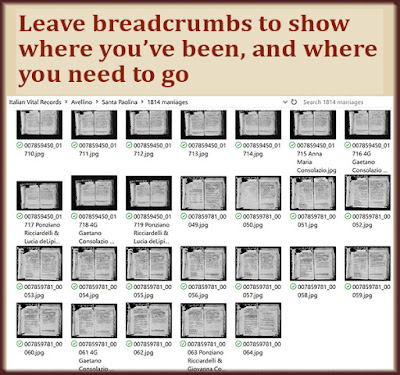Everyone in your ancestor's small town may belong in your family tree.
Small towns may hold more genealogy gems for you than big cities. Let's use my 2nd great grandmother's little town of Santa Paolina as an example. The town has a very small number of houses, and a very small number of families.
 |
| Small towns are a blessing when researching your family. |
Learn the Names First
There may be only a small number of last names in your small town. Get to know them by looking at each year's vital records index files. Get familiar with the names so you know how to spell them. Later, when you're looking at records, you'll recognize even the most poorly written names.
Most of the names in Santa Paolina were brand new to me. But I learned them fast.
Choose Your Entry Point
You're looking at this town because at least one of your ancestor's was born, married or died there. Start with that ancestor's documents. All you can find.
As you enter the facts in your family tree, you can begin to branch out.
I first found my 2nd great grandmother by going straight for her 1871 marriage record. Now I had her year of birth and her parents' names. I found her birth record and her parents' birth records. I searched the years around her birth and found her siblings' names. I figured out her parents' marriage year and found those documents.
Now I had the names of some of my 4th great grandparents. With those names, I could search for the siblings of my 3rd great grandparents.
The family is blossoming out so quickly!
Some of the siblings I'm finding have their marriage date and spouse's name on their birth record. Now I can pick nearly anyone and build out their wing of the family.
 |
| Leave no stone unturned. Each document could be important to you. |
Let Nothing Go to Waste
As I identify each relative's vital records, I change the original document's file name. Now I can see which documents I've processed and which may still hold goodies for me.
In a small town, you may have a very manageable number of documents for each year. Unless your only goal is to make yourself a long scroll of a family tree leading back to Charlemagne, harvest all those documents. They're all your people.
Think how many more DNA matches you can identify by spreading out your branches to take in that entire small town.
And speaking of big, wide, deep family trees:
Despite expectations of large families, the sad fact was that many children did not live long due to poverty or disease. I had differing birth dates for my grandfather's brother Felice. What I found going thru ALL the records was that the first 2 children born with that name died after only a few years. There was also another child with my grandfather's name Michael who didn't survive. Learning this made me recognize the hardships our ancestors faced.
ReplyDeleteIsn’t it amazing how emotional it is to learn of these deaths from so long ago?
ReplyDeleteI have used this method in a US county because every time I ran across a record, the name would be familiar and I knew there was a connection but couldn't quite remember. So I used Ancestry to build out a tree using documents to see how interrelated everybody was. I have over 3000 names in the tree now, most connected in some way or another. You can use Rootsfinder, Ancestry, or any offline software to do the same thing.
ReplyDeleteThat's fantastic, Clorinda. I did think this would be true in any country, especially in earlier times.
Delete